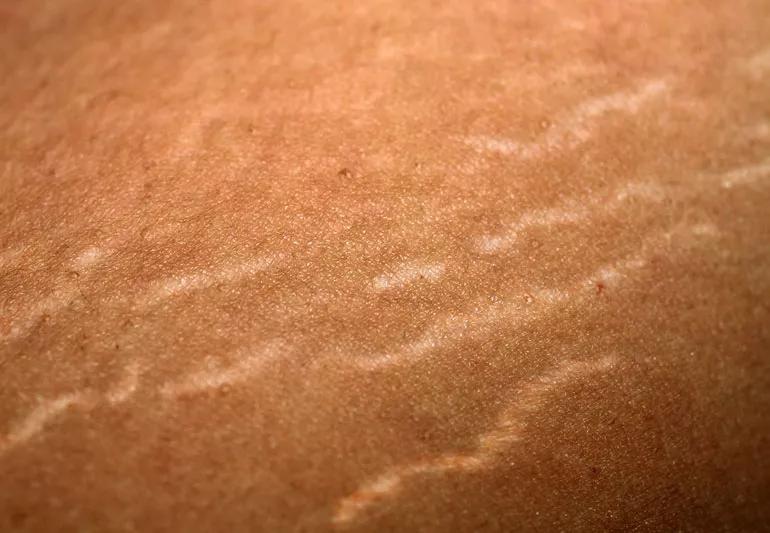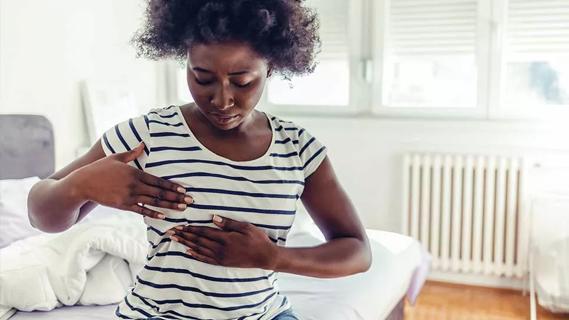Plus, a dermatologist tells you whether you can get rid of them

You may wonder if it’s normal to have stretch marks on your breasts. You’re not alone. Dermatologist Asfa Akhtar, DO, says most stretch marks are part of growing up and often fade with time.
Advertisement
Cleveland Clinic is a non-profit academic medical center. Advertising on our site helps support our mission. We do not endorse non-Cleveland Clinic products or services. Policy
“If you really want to get rid of them, a board-certified dermatologist can discuss your options,” Dr. Akhtar says. “Treatments start with topical therapy and then move forward to laser and energy-based treatments.”
Dr. Akhtar explains the what, why and how of breast stretch marks.
“Stretch marks on your breasts are a normal physiologic response to stretching of the skin most of the time,” Dr. Ahktar says.
New stretch marks look like curvy lines or streaks that are pink, red or purple in color. Older stretch marks appear lighter in color and fade with time but may never disappear completely.
Stretch marks on your breasts develop for many reasons, and those reasons aren’t the same for everyone.
“The dermis lies below the epidermis, which is the top layer of your skin,” Dr. Akhtar explains. “The dermis has a connective tissue framework that includes collagen, elastin and fibrillin.” Stretch marks can develop when there are changes in that connective tissue.
These skin changes can happen for several reasons.
Skin changes during puberty are the most common reason for stretch marks on the breasts.
“They develop when your skin rapidly stretches as your breasts develop,” Dr. Akhtar says. “We also see breast stretch marks in pregnant women as their breasts enlarge.”
Advertisement
Blame it on your parents. “Some people are just genetically predisposed to develop stretch marks,” Dr. Akhtar says.
Comorbidities are two or more medical conditions that occur together or right after each other.
“The development breast stretch marks may come in concert with other conditions, too, such as obesity or Cushing’s syndrome (which is a disorder caused by too much of the stress hormone cortisol),” Dr. Akhtar says.
Adults can develop breast stretch marks from taking medications that suddenly stretch their skin. These medications include long-term use of systemic corticosteroids.
Sudden weight fluctuation, including pregnancy and growth spurts, can cause breast stretch marks. Weight gain is associated with increased fat and connective tissue, which causes breast size to grow and leads to the development of stretch marks.
On the other hand, weight loss can decrease the level of collagen and elasticity of the skin, which can also result in stretch marks.
Rapid muscle mass increase, which can happen in weightlifters, is another common cause of stretch marks.
Just like scars, stretch marks change in appearance the longer you have them:
Treatments for breast stretch marks aim to increase skin collagen levels and hydration. But Dr. Akhtar says timing is everything.
“The sooner you see a board-certified dermatologist — when the stretch marks are still new and purplish or pinkish in color — the easier it is to treat them,” she says. “Once they become older, it’s not easy to get rid of them. There are some treatments but few are effective.”
If you're breastfeeding or pregnant, check with your doctor before starting any treatments for stretch marks.
Conservative therapies are mostly DIY and have varying levels of success, Dr. Akhtar says. Dermatologists sometimes prescribe a treatment you put on your skin (topical) called tretinoin. Over-the-counter treatments also involve skin massage and include:
While laser treatments are often more effective than their topical counterparts, they’re also pricier. “The Catch-22 is that if you come in, insurance would cover the office visit and a tretinoin prescription,” Dr. Ahktar says, “but if we go to the next level of treatment — which is usually lasers and energy-based devices — that’s not covered.”
Advertisement
Dermatologists treat breast stretch marks with lasers that include pulsed dye lasers, ablative lasers, carbon dioxide lasers and YAG lasers.
“The pulsed dye is the best laser for new stretch marks,” Dr. Akhtar says. “You can get excellent results. These lasers target the redness and purplish discoloration, and they’re also safe — and even approved for use in infants.”
If you have darker skin, though, use caution, as most lasers were studied on non-ethnic skin and may burn or discolor the skin. Look for a board-certified dermatologist who understands the skin’s structure and different skin types.
Older stretch marks are harder to treat. It’s not possible to completely clear older stretch marks, and it will likely take several sessions and a combination of treatments to get the best results.
“We haven’t yet found that silver bullet to eliminate older stretch marks,” Dr. Ahktar says adds. “There might be some improvement, but you will not be 100% satisfied.”
Doctors can achieve varying degrees of success by combining laser treatments with other options, including radiofrequency devices, microneedling devices, platelet-rich plasma (PRP), ultraviolet and infrared light therapy. Dr. Akhtar says fractional ablative and non-ablative lasers work best on older stretch marks.
Advertisement
When making treatment decisions, be sure to carefully weigh the risks, benefits and costs.
“I don’t encourage my patients to spend a lot of money trying to get rid of older stretch marks,” Dr. Akhtar says, “but more advanced lasers are coming out every day. I’m hopeful that we’ll be able to help patients with older stretch marks soon. The key thing to remember is that the earlier and more aggressively we treat them, the better the results.”
Preventing stretch marks is possible but unfortunately not likely. Doctors recommend keeping your skin well hydrated and, whenever possible, avoiding sudden changes in body weight.
There’s no firm evidence in support of the use of creams and massages as a means to prevent stretch marks, but coconut oil and products containing hyaluronic acid hydrate your skin, which may help.
“While not everyone develops stretch marks on their breasts when they hit puberty, massaging and moisturizing the area may help before they develop,” Dr. Akhtar says.
The good news, though, is that breast stretch marks are completely harmless — so your best bet is learning to live with them.
Advertisement
Learn more about our editorial process.
Advertisement

For large breasts, wearing a bra may provide support that helps alleviate back pain — but if you’re comfortable without one, go for it!

Feelings of sadness or dread when your nipples are touched may be linked to dysphoric milk ejection reflex (D-MER)

Taking precautions like eating healthy, stopping smoking and getting regular screenings can help protect against breast cancer

Massaging your breast tissue can help reduce breastfeeding pain, treat lymphedema and find cancer early

A dermatologist dishes on the dirty truth

Early attention to skin wounds can help minimize their appearance later

Your scar will heal best if you keep the area clean, dry and covered for an appropriate amount of time

A second appointment is common, especially after your first mammogram and if you have dense breasts — but it doesn’t necessarily mean anything is wrong

Start having sex about 72 hours before ovulation, then at least every other day during your fertile window

Attachment theory suggests that your earliest relationships shape connections throughout your life

It isn’t a recognized mental health disorder, but research shows that problematic social media use can negatively affect your mental health, self-esteem and sleep